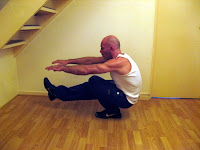The training principle is same as the other exercises
Push up and
Pull up
Choose one of the following variations as a starting point and perform 3 sets of between 4 and 8 repetitions with periods of between 1 and 2 min of rest between each set. When you can do 3 sets of 8, move on to the next exercise in the progression.
All the necessary information (Form, muscle targeted, etc) about Squat can be find in my previous article
here.
1. Assisted squats
Stand up straight with the feet shoulder width apart, or slightly wider. Rest your hands on the back of a chair in front you. Lower yourself till your thighs are parallel with the floor, keeping your back as straight as possible.
Pause for a moment, before pushing yourself up using mostly leg power.Try to keep the arms fairly straight. Your heels should remain flat on the floor throughout the exercise.
 |
| Assisted squats |
2. Deep assisted squats.
Same as above, but squat through the full range of motion.
 |
| Deep assisted squat |
3.Squats.
Without any help, lower yourself till your thighs are parallel with the floor, and come back up.
See more information about squat
here.
 |
| Squat |
4.Deep squats.
Same as above, but squat through the full range of motion.
 |
| Deep Squat |
5. Bulgarian split squats.
Rest your back foot on an elevated platform, with the sole pointing up. Keep your weight over your front leg as you lower yourself.
 |
| Bulgarian split squat |
6. Assisted one legged squats.
Performed with a bench or a chair next to you, extend one leg straight in front of you, and lower yourself all the way down, till your butt touches your heel. The heel must remain on the floor however. Help yourself back up by pushing on the chair.
 |
| Assisted one legged squat |
7. One legged squat
Do the same as above step without any help from your hand.
Congratulation! You did it!!
 |
| One legged squat |
Note
Once you master the one-leg squat, take a little time to build up your reps. After you can do about 20 one legged squats in a row for each leg, you already had super legs, stronger than most of the guys in gym today.
But you still want to add more mass to your leg, a combination of bodyweight exercises and barbell work or strict barbell work will get you better results. See my FAQs in my recommended routine about intergrated barbell squats and deadlift.







Comments
Post a Comment